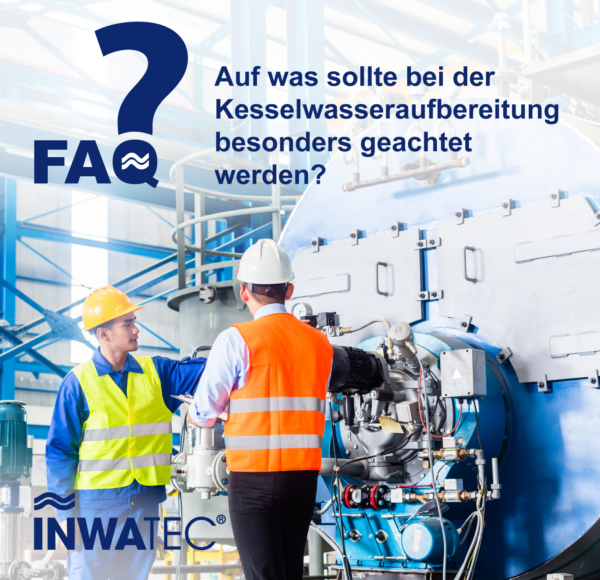FAQ – Frequently asked questions
Are your systems ready for inspection in accordance with the 42nd BImSchV?
Expert inspections under Section 14 of the 42nd BImSchV are essential for operators of evaporative cooling systems, cooling towers, and wet separators. However, many initial inspections are still pending, and not everyone is aware of their obligation to perform independent system inspections.
How does such an inspection work? What requirements must be met? And what should you do if you’re unsure about the classification of your system? We’ve gathered answers to these and other key questions in our latest blog post.
Learn more about properly uploading inspection reports, the required documentation, and why classification on the KaVKA-42.BV online portal can sometimes be confusing.
Here you can find the blog post.
Do you have questions about your system or need assistance with inspections? We’re happy to help!
Do biodegradable products perform as well as conventional ones in cooling water treatment?
Yes, biodegradable products like our INWAgreen line can provide equally strong performance as conventional chemicals – with the added benefit of being environmentally friendly. INWATEC’s INWAgreen products are specially designed to deliver optimal efficiency in cooling water treatment. They offer excellent corrosion protection, stabilization of the hardness in the water and scale prevention.
These biodegradable products have undergone rigorous testing in our Research & Development department to ensure they meet the highest standards and perform across a wide range of applications. With INWAgreen, you’re choosing sustainability without compromising on performance.
By working closely with INWATEC, customized solutions can be found that are both eco-friendly and high-performing – supporting both our clients and the environment.
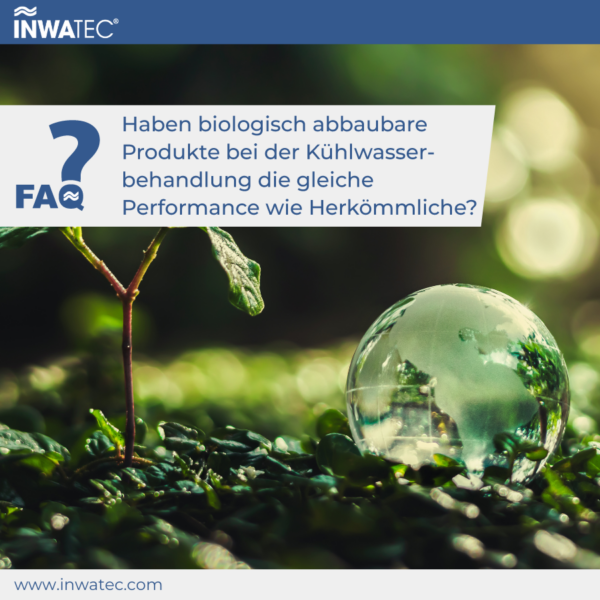
Why is efficient water treatment essential in dairies?
Efficient water treatment in dairies is essential, as water plays a central role in almost every production step. Whether for cooling, cleaning, or as an ingredient, water quality directly impacts product quality and operational efficiency.
INWATEC offers tailored solutions to optimally support dairies. With our online monitoring, you can keep track of key water parameters at all times – allowing you to detect and resolve issues early. Turbidity measurement, for example, ensures precise control of water quality, which is particularly essential for hygiene and product safety. In addition, we offer individually tailored biocide programs to combat germs reliably and permanently without impairing the water quality. Monochloramine offers a sensible and effective way of keeping water germ-free without contaminating it with degradation products.
Another highlight is the treatment of evaporated condensate, which can be reused as cooling water after treatment. This water recycling significantly reduces freshwater consumption, making an important contribution to sustainability.
These technologies not only protect your equipment from deposits and corrosion but also optimize water usage. Sustainability and cost efficiency go hand in hand, ensuring smooth operations and high-quality end products.
In summary, well-thought-out water treatment, combined with INWATEC’s advanced monitoring and treatment methods, ensures top product quality, reduced operational costs, and sustainable environmental protection.
These biodegradable products have undergone rigorous testing in our Research & Development department to ensure they meet the highest standards and perform across a wide range of applications. With INWAgreen, you’re choosing sustainability without compromising on performance.
By working closely with INWATEC, customized solutions can be found that are both eco-friendly and high-performing – supporting both our clients and the environment.
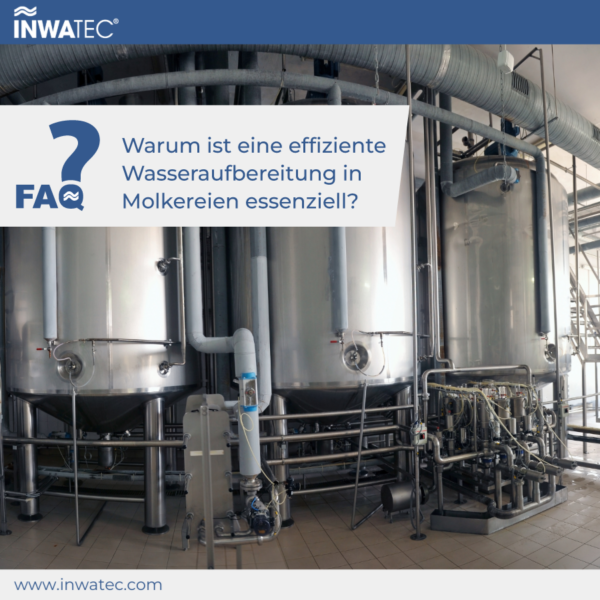
What special applications does INWATEC offer me?
INWATEC offers, for example, two innovative special applications that both save costs and protect the environment.
1. Hydroxide sludge-free emulsion splitting:
Our patented emulsion splitting technology can completely avoid the hydroxide sludge that is usually produced. This leads to a significant improvement in the eco-balance and considerably reduces disposal costs. Our process safely transports heavy metals into the oil phase and then disposes of them via the existing oil disposal system. This optimization of chemical splitting reduces the hydroxide sludge produced and thus directly lowers disposal costs without requiring any changes to the existing process technology.
2. Dust binding:
Dust emissions are a growing environmental problem in many industrial sectors. INWATEC has developed technologies that effectively minimize the generation of dust during the processing and storage of materials such as coal, ores and sewage sludge. With minimal use of water and the use of efficient binding agents, we reduce dust formation on conveyor belts and during storage in bunkers. In addition to specialty chemicals, our tailor-made solutions also include dosing equipment, control and regulation units and storage options that are precisely tailored to your application.
INWATEC – your expert for innovative water technology! Please contact us for further information.
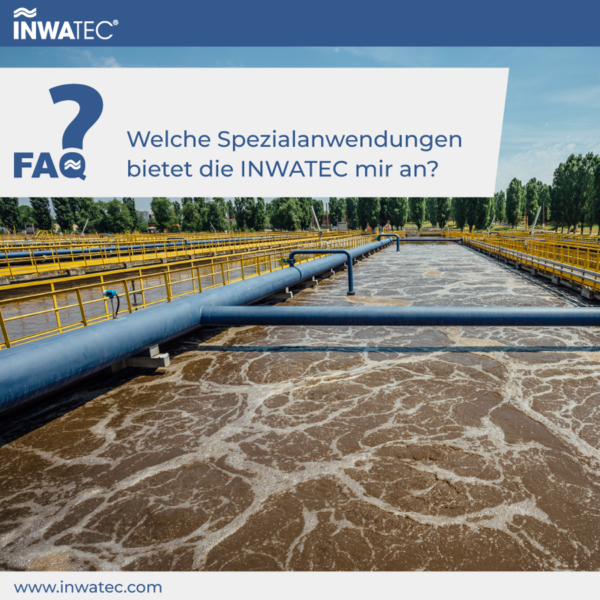
How do I get a reliable and continuous overview of my legionella concentration in the cooling water?
Cooling water is used in industrial processes because it is the most efficient form of cooling. Unfortunately, water is also an important environment for microorganisms and bacteria such as legionella. The 42nd BImSchV therefore regulates the hygienic operation of evaporative cooling systems, cooling towers and wet separators.
To keep a permanent overview of the legionella concentration in your cooling system, we have a solution: our fully automated INWATROL L.nella+ measuring device.
What does the INWATROL L.nella+ include?
Fast results: The device determines the legionella concentration in the cooling water fully automatically within just 5 hours.
Online access: Results in CFU/100 ml can be viewed at any time.
Alarm notification: If the legal limit values are exceeded, you receive an alarm notification immediately.
Optional biocide dosing: Automated and on-demand biocide dosing when activated and connected to an IBC.
Our patented INWATROL L.Nella+ offers you many advantages. You have low costs per analysis and a high correlation to the accredited measurement method in accordance with DIN EN ISO 11731:2019-03. In addition, your hygiene status in the cooling water is permanently available and reliable. This means you can react quickly if necessary to prevent further spread.
Get permanent control of your water quality now and ensure hygienic operation of your cooling system with our INWATROL L.nella+!
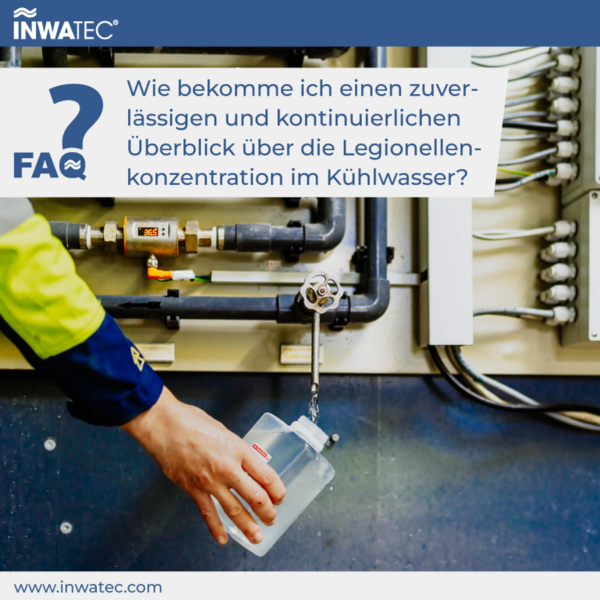
How can I reduce the cleaning effort and water consumption when operating a pasteurizer in breweries?
Pasteurizers in the beverage industry require intensive maintenance and cleaning in order to make the processes as efficient as possible. Contamination of the water with the end product can lead to considerable problems and excessive biofilm formation. This usually results in a very high cleaning effort, which can also lead to production downtime. By monitoring the biofilm and adjusting the biocide dosage accordingly, cleaning work can be massively reduced (by up to 75%). This monitoring is carried out with the help of our INWATROL expert monitoring device. The most important component in this area is our INWAsense biofilm sensor, which continuously monitors the biofilm. By dosing our chlorine dioxide-based biocide, it is possible to penetrate the biofilm and impede its growth in the pasteurizer. In addition to quality control, the beverage industry is also faced with the challenge of keeping water usage as low as possible in order to save not only the main resource, but also costs and energy. Continuous water treatment helps to reduce the number of manual pasteurizer cleanings required.
It is worth noting that for one of our brewery customers, each additional cleaning involves the use of 20 to 30 cubic meters of water. The less frequently cleaning is required, the greater is the water saving. Before the implementation of comprehensive water treatment, the brewery in this case had to do this every two weeks. By using INWATEC’s effective solutions, the cleaning interval could be extended to six to eight weeks. This practical example illustrates the vital importance and numerous benefits of comprehensive water treatment in breweries and other companies in the beverage industry.
If you have any questions about your treatment concept, please do not hesitate to contact us. We will be happy to support you with our expertise.
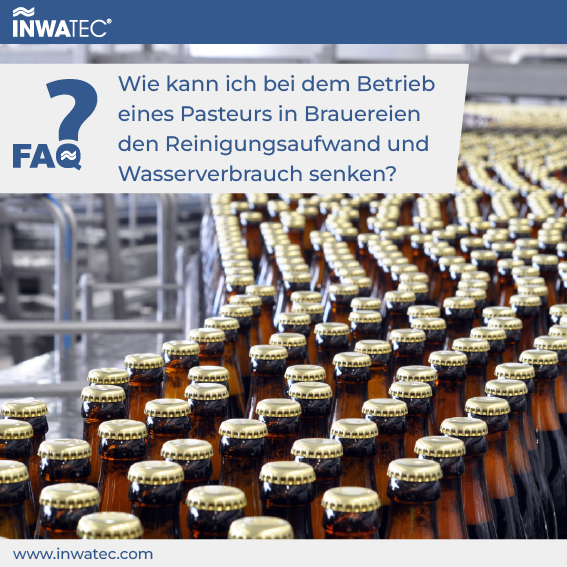
What do I keep in mind when recommissioning my galvanized cooling tower?
The recommissioning of a galvanized cooling system is a crucial time that influences the maximum operational capability and service life of your system. Special attention is required here to ensure effective passivation and therefore optimum corrosion protection. In contrast to stainless steel cooling systems, galvanized units require intensive passivation, which should be carried out before regular commissioning. Passivation ensures that a protective layer is formed on the galvanized steel.
According to the recommendations of the cooling system manufacturers, it is advisable to carry out passivation without a load on the cooling system. This means that passivation takes place before final commissioning of the system to ensure that no heat is applied to the shell and tube heat exchangers. In this way, the passive layer can form optimally. Furthermore, it is also possible to carry out passivation under load. INWATEC can adapt the water treatment concept to your individual requirements and conditions.
During the whole passivation period, permanent and comprehensive water treatment is essential. The cooling systems should be operated continuously and the pumps must run continuously during this time. Downtime can threaten the success of passivation. Continuous monitoring of the pH value is also essential. Therefore, precise monitoring of water parameters and careful dosing of chemicals throughout the passivation process is very important.
Changes in water chemistry should only be made after the passivation process has been completed. It is important to make such changes slowly and gradually and to document the effects on the passivated zinc surface. INWATEC will be happy to help you draw up a concept for the passivation of your new or existing galvanized cooling tower and keep an eye on the water parameters at all times in order to comply with the required limit values. We would be happy to advise you on all aspects of water treatment. Please feel free to contact us at any time.
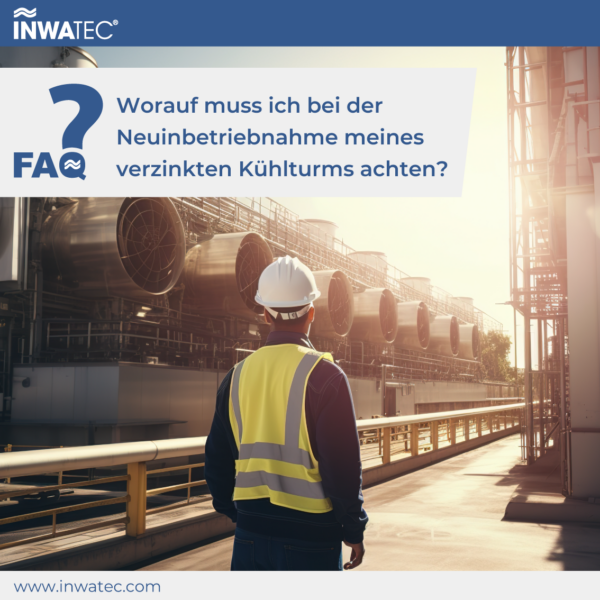
What relevance does sustainability have in water treatment?
INWATEC has always been committed to developing innovative ways of treating water that not only protect the environment, but also increase the efficiency and profitability of our customers. In chemical water treatment, this means developing processes and technologies that use fewer resources and generate less waste. We are pleased to announce that there will be significant news in the area of sustainable water treatment at INWATEC in the near future. We are currently researching a new sustainable product range.
Sustainable water treatment methods offer a particular win-win situation for the following reasons:
- Cost reduction: sustainable approaches often lead to more efficient use of water and chemicals, which can significantly reduce operating costs.
- Environmental protection: Reduction of fresh water and wastewater volumes, as well as minimizing the discharge of water-polluting and/or eutrophying substances.
- Innovation: The goal of greater sustainability drives us to find creative solutions that are competitive in the long term.
INWATEC is currently developing products and solutions that not only improve water quality, but also increase resource efficiency. In doing so, we ensure that our customers not only benefit from the environmental advantages, but also from the economic benefits. At INWATEC, we are proud to be an active part of this change and look forward to shaping a more sustainable future together.
We are currently researching our INWAgreen product range, which focuses on degradable raw materials and thus reduces the impact on humans, animals and the environment. Among other things, this is achieved by replacing phosphate and decarbonizing production and raw material sourcing. We will be able to present initial results on this later in the year. So you can be very excited.
What do I need to consider when operating my cooling system in winter?
Winter is coming and temperatures are falling. Therefore, you should consider the following things when operating your cooling system:
Basically, a low heat load is passed through the system.
Stagnation, even within parts of the system, should definitely be avoided, otherwise corrosion and/or microbiological growth can occur. When operating fans with frequency converters, you should also pay attention to the optimal flow conditions for your mist separators, otherwise aerosol can be ejected. When the fans are switched off, a lot of aerosol is ejected in the vicinity of the evaporative cooling system, as the natural draft effect is not sufficient to provide optimal flow to the mist separators.
If you want to take your system out of operation for the winter, the requirements for restarting it in accordance with 42nd BImSchV must be observed in spring.
To do this, please use the 42nd BImSchV checklist.
Among other things, the condition of the system must be assessed by a hygienically qualified person and an additional water analysis for legionella must be carried out.
This needs to be documented in your operations diary.
Low temperatures often result in less microbiological growth and thus less consumption by biofilms.
The dosage of disinfectants used should be adjusted as needed. This is usually significantly lower. And any overdose should be avoided.
Basically, it is important to ensure that the water in the system does not freeze.
Ice can damage equipment, especially mist eliminators and packings.
We therefore recommend a thorough inspection of all hygienically relevant parts of the system after the cold period.
If we can help you adapt your system to the current weather conditions, please feel free to contact us by phone or email at any time.
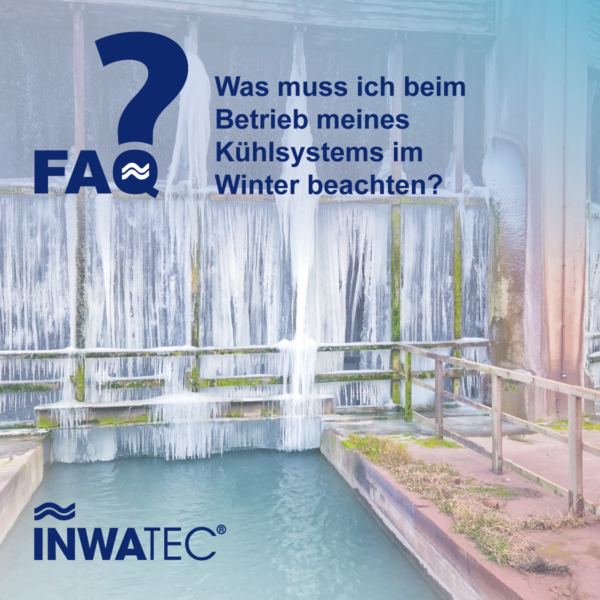
What is the INWATROL adplus and what is it used for?
Our INWATROL adplus is an innovative system for generating monochloramine. Monochloramine is produced by combining two components and acts as a disinfectant that is used, among other things, for the treatment of cooling water. The components are combined fully automatically via our INWATROL adplus. Since the biocide effectively disperses biofilms in the cooling system, you can be assured of hygienic operation of your cooling system thanks to its mild and targeted mode of action. Monochloramine ensures low corrosion rates by targeting microorganisms (slime-forming bacteria, sulfate-reducing bacteria, legionella, pseudomonas, algae, filamentous bacteria, yeasts and fungi).
The system can treat a system volume of 500 to 100,000 m³ and is therefore particularly suitable for large cooling systems. Dosage is based on demand and can be individually adjusted. With the help of our data management system you have the possibility to monitor your cooling system online at any time and to react directly to automated alarm notifications.
We would be pleased to present you more about our new system. Just contact us at any time.
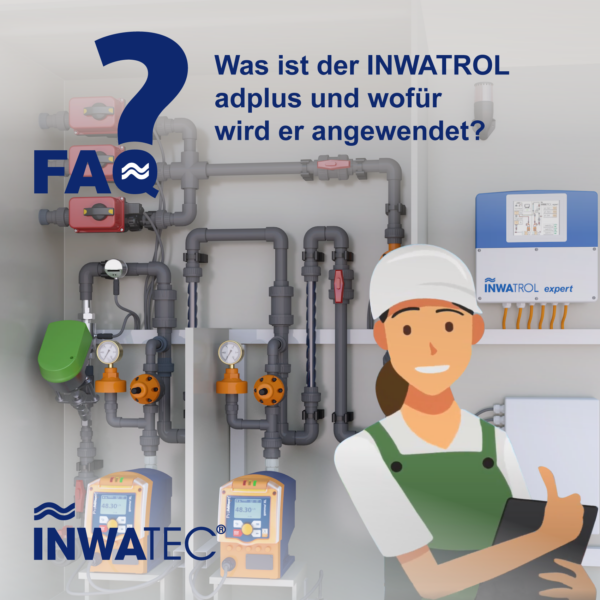
Which water treatment program is right for my steam boiler system?
To protect your boiler system from deposits and corrosion in the long term, chemical water treatment is essential.
Deposits inhibit heat transfer and lead to increased energy consumption. A circumstance that must be avoided especially with the ever-increasing fuel prices. Corrosion can cause considerable damage to your plant. Long-term production losses are the result.
But which treatment chemicals can I use to protect my system?
First of all, it is necessary to check the extent to which steam-volatile conditioning agents can be used in your process. For example, should the steam come into contact with food, non – steam volatile products should be used.
In addition, the choice of treatment chemicals depends on the type of water treatment and the quality of their additional water.
Your friendly INWATEC representative will be happy to advise you on which oxygen binders, residual hardness stabilizers and alkalizing agents can be used in your steam boiler system.
The system can treat a system volume of 500 to 100,000 m³ and is therefore particularly suitable for large cooling systems. Dosage is based on demand and can be individually adjusted. With the help of our data management system you have the possibility to monitor your cooling system online at any time and to react directly to automated alarm notifications.
We would be pleased to present you more about our new system. Just contact us at any time.
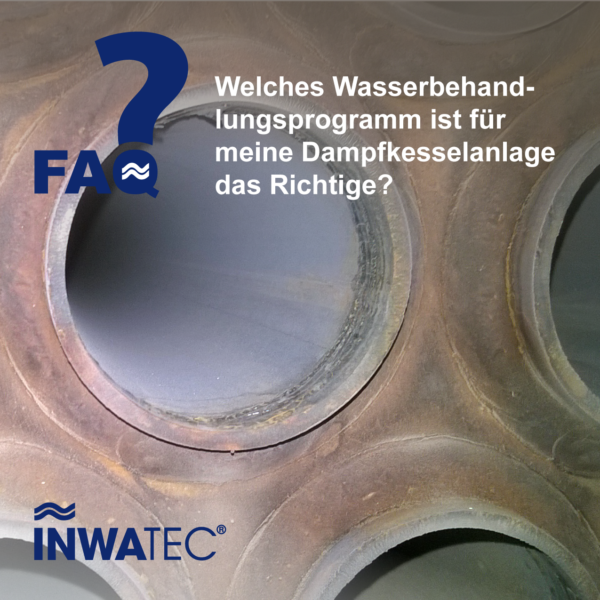
Is there a possibility to clean plant components such as heat exchangers on site?
In the best case, deposits are already avoided during operation of the plant.
Depending on which water constituents are critical, various active substances can help (for potential gypsum or lime deposits, e.g. phosphonates or polycarboxylates).
In case of biofilm formation, disinfectants and/or surfactants are usually the right choice. We will be happy to provide you with technical advice to optimally match the water quality to your process.
If the heat exchanger is occupied, but still continuous, cleaning can be carried out on site in any case. This involves flowing through the heat exchanger in the bypass with the aid of a cleaning station. A cleaning solution specifically adapted to your needs is prepared in the cleaning station. Which cleaning solution is used depends on the type of contamination.
Chemical analyses are carried out in advance. The system material is protected by special inhibitors during cleaning.
The cleaning and an efficient design of the cooling water treatment, to avoid deposits for the most part in the future, is carried out by experienced INWATEC employees.
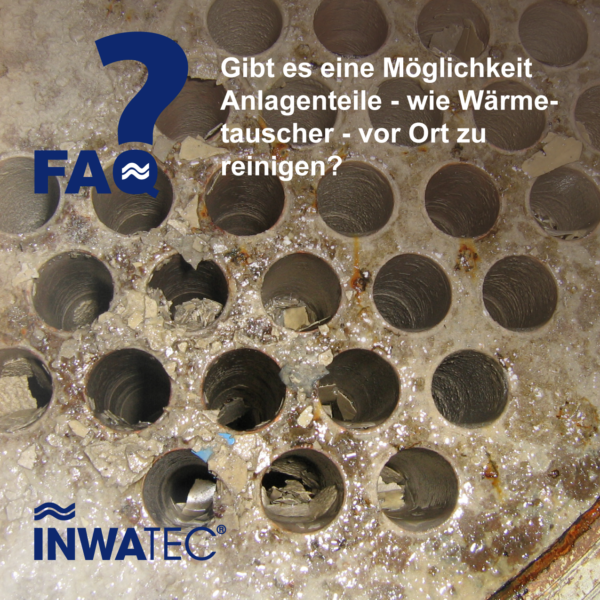
How do I avoid deposits in the heat exchanger?
In the operation of heat exchangers, many different parameters play a decisive role in addition to the water quality. In particular, the flow velocity is an important aspect in the mode of operation.
We recommend a flow velocity of at least 1 m/s. However, the flow velocity must not be too high either. Too high a flow velocity can lead to corrosion, e.g. erosion corrosion. Please be sure to observe the manufacturer’s specifications in this regard.
The maximum wall temperature plays an important role. If possible, we place the water treatment on your most critical heat exchanger. In addition, to the lime-carbonic acid equilibrium for estimating the tendency for lime deposits, we also calculate the indices for e.g. phosphate, zinc or silicate solubility to ensure trouble-free operation. Finally, it is of course important to effectively limit microbiological growth to avoid the formation of biofilm.
Have we aroused your interest? Then contact us by e-mail at info@inwatec.com.
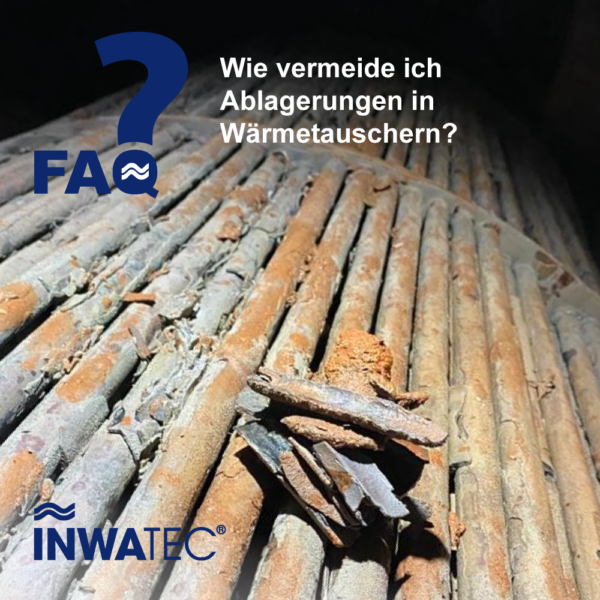
Should I turn off my ventilators on the cooling system if the legionella concentration is raised?
In the past, the recommendation was often made to switch off the fan on the cooler in the event of an increased legionella concentration. But does this measure really make sense?
The answer is: No!
If the fan in the cooler is switched off, the temperature of the cooling water increases. As a result, microbiological growth is favored. The legionella concentration can then increase even further.
In addition, the droplet separator (which prevents aerosols from escaping from the evaporative cooling system) no longer receives an optimal flow, so that aerosols can be discharged.
It would be better, in the case of an increased legionella concentration, to lower the blowdown limit. In this way, more water is discharged from the cooling system, which favors the dilution effect. In addition, the biocide dosage should be increased.
A subsequent root cause investigation should then elucidate how the increase in Legionella concentration occurred.
You are welcome to contact us if you need help with this. We will be happy to assist you.
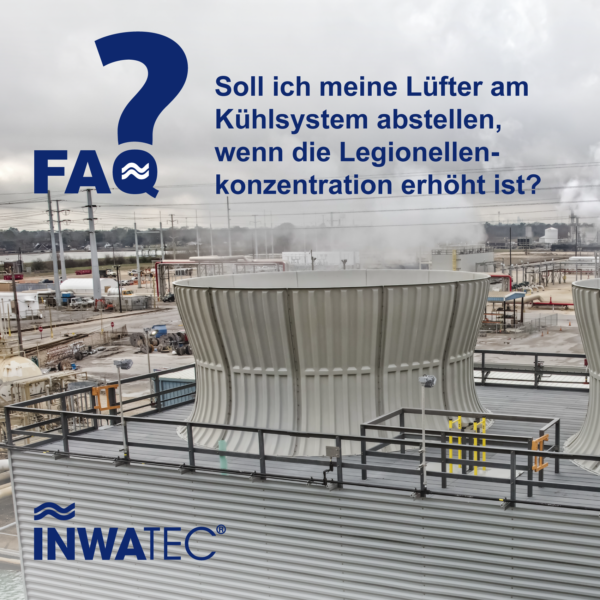
How does corrosion occur and how can I measure it?
Corrosion is a chemical-physical reaction between metals and their environment and quickly leads to high maintenance costs or even production losses in cooling circuits. There are many types of corrosion in cooling systems, such as microbiologically influenced corrosion and pitting corrosion. In microbiologically influenced corrosion, anaerobic bacteria, for example, can oxidize the steel, while “pitting” is caused by anions (e.g., sulfate or chloride) that promote corrosion, among other things.
The typical measurement of corrosion rate is made using corrosion coupons and is measured in mm/year of material loss. However, in addition to material loss, the type of corrosion is also important and can be determined by using the corrosion coupons. For this purpose, the simple installation of the coupons in a measuring fitting can provide more information. In addition, INWATEC has the possibility to monitor the corrosion coupons in our INWAview system with the help of a high-resolution HD camera. Thus, the coupon can be viewed at any time and mechanisms of corrosion can be detected at an early stage and appropriate measures can be taken.
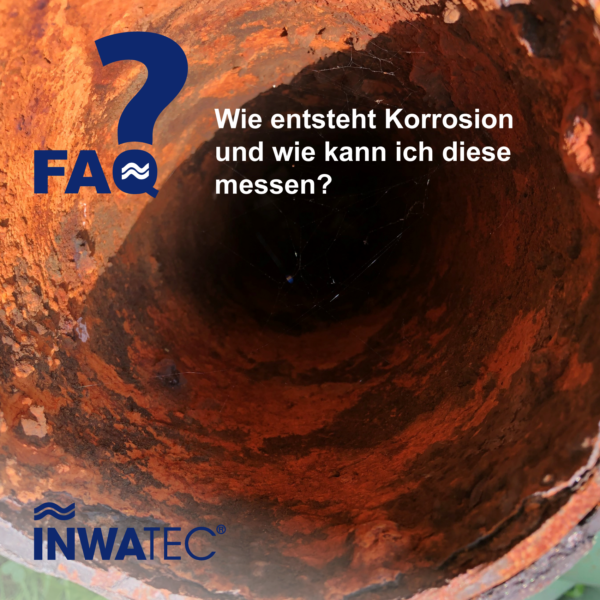
Which biocides do I use in which application area?
In principle, biocides are divided into oxidizing and non-oxidizing biocides.
Oxidizing biocides act through a chemical reaction. While the microorganism is oxidatively damaged, the disinfectant is reduced. Often these redox reactions are pH dependent. Oxidizing biocides often react with organic water constituents.
Non-oxidizing biocides, on the other hand, have a wide variety of effects. For the success of disinfection, a sufficient concentration of active ingredients is obligatory here. The active ingredients can act both at the cell membrane and within the cell. The mechanism here defines how fast the biocide acts. Slow-acting biocides are unsuitable for dynamic systems. In terms of wastewater, this type of product affects the GL value, the COD and, in some cases, the AOX concentration.
Depending on the application, even a combination of active ingredients can be useful. Non-oxidizing biocides are less sensitive to organic cooling water constituents. The combination with oxidizing agents can have a synergistic effect in highly loaded cooling systems.
In any case, please consult a competent contact person. The use of biocides must be targeted and correct for legal and environmental reasons. According to the motto: As much as necessary, as little as possible. We will be happy to support you here.
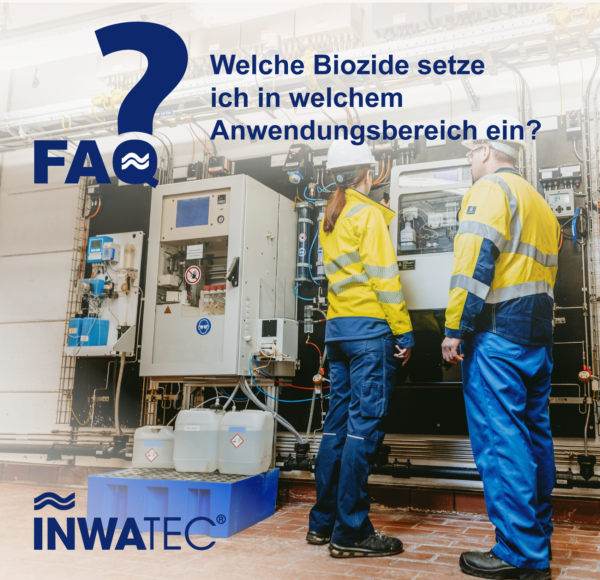
What should be paid special attention to in boiler water treatment?
In boiler water treatment, special attention must be paid to three factors: Operational safety, occupational safety and economic efficiency.
Operational safety includes compliance with guidelines, documentation of water analyses, flawless treated feedwater, availability of all operating equipment and the maintenance schedule.
In the context of boiler water treatment, occupational safety refers to the handling of chemicals for water treatment by skilled persons. This also includes the risk assessment and the testing of safety fittings.
Economic efficiency includes, above all, a cost-benefit calculation of the amount of steam and the discharge. In addition, the number of damages and repairs must be taken into account. The current state of the technologies as well as the efficient
heat recovery should also be integrated into the water treatment.
INWATEC will of course help you to realize all three factors properly and in the best possible way. You will not have to worry about your boiler water in the future thanks to our help.
